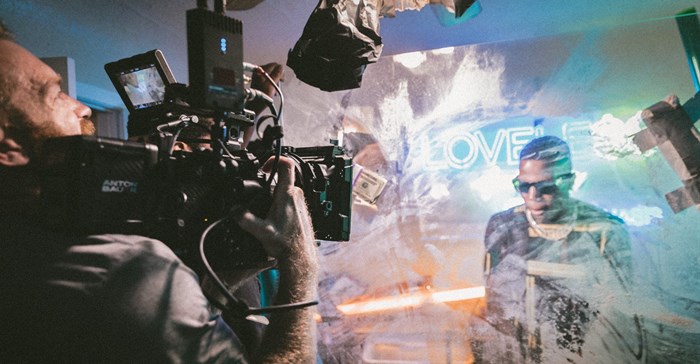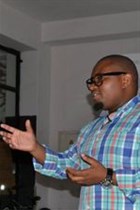
A desktop strategist is exactly that. A strategist that does all his or her strategies based off of research done on the laptop. All information is obtained via search engines. That’s the information from the same sources that everyone else is privy to.
This promise came to fruition when I worked on Edge, a hops-infused cider that brings cider and beer together.
Look at all successful brands or brand campaigns. At the core of their successes, is people; the ones that are going to be consuming the product or service. Every marketer who has had success knows that the understanding of your audience is paramount to unravelling the true potential of an idea (a branded product or service).
Thomas was instrumental in creating this environment where the focus would be on people. For Edge, this is where its true test lay, could it connect or resonate with the people it intended to target?
As Diana Von Furstenberg said;
It's not about going to a party. It's life as a party.In the pursuit of ‘people knowledge’, we left our boardrooms and went where people actually lived; the real world. We went from Tembisa to Atteridgeville to Soweto. When we arrived at certain places where activity was lacklustre, we nightclubbed our way into people’s lives. We drank, ate, and partied with a purpose. This process brought us intimately closer to the consumer. By being this close to people, it gave us not just insight into their lives, but more importantly, an ownable relationship.
Most brands compile a fictitious profile or caricature, a multilayer compilation of third-party and secondary research. Sometimes, brands competing in the same category end up with the same consumer profiles. Precisely why the deep understanding of the people we aimed to target through the immersions was critical for Edge, the brand team and agency partners.
Through this process, we were able to build a real persona for the brand. I know who they are, where they live, how they live, where they work and why they are so in love with their neighbourhoods.
For example, when most research says that people in the township aspire to live in the suburbs, our target market is more than happy to stay in the township. This is no indication of their lack of aspirations, but the pride that resides within. They know about the “north”, but they prefer to keep it real in the south.
We knew exactly who our target market was. They were a real human being. This is critical to note because this allowed us to minimise subjectivity as much as possible. When I stood in front of the Distell brand team and the board, talking about the consumer became both a personal and emotional moment because it was real.
In a room full of agency partners, when we were trying to establish who this person was, I mentioned Kwesta’s music video; Spirit, as the perfect showcasing of the people that we were targeting. Raw. Real. People who live in the real world, experience real life and real challenges, not models or Instagram influencers.
Thirty seconds into my attempt at describing who “Dumisani” was, and why the Spirit video aptly portrayed his life, Vithesh Ramklown, global brand development manager for Edge, halted my awful attempt at explaining the video and insisted that we rather play it.
Apart from everyone seeing and understanding why the video succinctly captured our audience, what happened at that moment is exactly how every target market section of any strategy should make everyone feel; emotionally connected. For the first time in a long time, advertising felt real. In fact, it didn’t feel like advertising, it was a true story.
With the crystal understanding of our target audience, matched with the product’s unique intrinsic; the Edge drinker (Dumisani) and Edge are a match made in the world of beer and cider. Dumisani is a man who cannot be confined to the norms and expectations of society, what you think you know about him, his truth is the exact opposite. Just like Edge, Dumisani is unique, you cannot box him into anything that pre-defined.
Never in my advertising or strategy life have I been part of a strategy or brand building exercise, where the brand’s competitiveness was crystallised in vernacular. It’s incredible. I’ve been in and done many strategies, but never have I, nor was there any intention from everybody involved, to articulate anything in the language of the people that we were targeting. This is a critical point to simmer on.
Ramklown insisted on being as close to the consumer as people, not just from a research point of view, but also through language. This demonstrated the intention to be authentic (this was the first time where the word ‘authenticity’ actually meant something), to people, and the process as well. It was the first time I heard a vernacular term or word being spoken so much in an ad agency or amongst partner agencies. Not as a catch-phrase, but as a strategic key point.
Ramklown asked; “What would a panel beater say if they were to drink Edge? Sechaba Suping, a BTL creative answered; “Izokumangaza!”. This implied that there was nothing like it. This was one of the seminal moments, because once “Izokumangaza” was out in the open, we were all never the same again. That became the gospel.
Which eventually became our proposition to consumers. Never in my life have I expressed a key strategic point of discussion in vernacular. As expected, this became a point of contention and the brand team, Thomas and the CMO of Distell, had to fight to keep it. It is not every day that a brand’s proposition is expressed in isiZulu.
The reason it was kept is our ‘people immersion exercise’ enabled the brand team to fight for it. We had done the work and we, therefore, knew the customer better and were absolutely certain that Izokumanagaza would work.
In advertising, usually creative development takes precedence over every department. There’s never enough time to do anything except creative work. Working on Edge was a great and refreshing experience. So, when the client; Ramklown, insisted on strategy leading the launch process, I suspected something magical might happen.
He put emphasis on understanding through research. We investigated every possible aspect that would influence the success of the launch. Together with consumer research, we investigated trade, competitors, and all the factors that influenced the beer category. At a certain point in the process, I knew more about beer and cider than my anatomy. That’s how intimate the process became.
The strategic process achieved key critical seminal guard rails:
Strategically, we were at an advantage against the competition.
I was just lucky to be part of the Net#work BBDO team. Usually, such a project is undertaken and led by a lead agency, and then partner agencies get involved later. Even though BBDO played a key role of lead strategy and creative, it was truly a collaborative effort.
In the room, there was just a group of people who all shared one vision; to launch Edge in an emphatic fashion. To make a statement. To be noticed. To be distinct, and to breakthrough. To achieve this, we all went through a rigorous process of back and forth debating key issues.
We had relentless workshop sessions, where agencies from creative to design, to digital, PR and BTL all joined forces to produce relevant solutions that were appropriate for the goals and ambitions we had for Edge.
As advertising people would say; the idea was cracked. A rigorous process of a hundred concepts, a couple of storyboards, a thousand scripts and a million executions, the creative guys managed to capture the essence of “Izokumangaza”.
Based on the strategic work done upfront, the creative challenge was for the executions to deliver on the set objectives, ensuring that we overcame the strategic battles that stood in front of us. The big challenges were:
Every creative idea was reviewed against what Edge had to achieve strategically. Which was amazing, because it emphasised the critical role of strategy. “Which Must Win Battle is the idea answering?”, Ramklown would ask.
Never satisfied with the ideas brought forward, this critical question eventually led to the concept of Where Beer And Cider Meet. Sounds simple, but the thinking behind it is powerful. Then, like magic, The genius TVC idea was conceived. The creative guys outworked themselves. What an incredible piece of work by the Net#work BBDO creative team.
Beer and cider brands in South Africa did the work for Edge.
The TVC concept is genius. A marketer’s dream. How do you overcome the hurdle of having a limited budget? This is where the genius comes in.
Edge uses and capitalises on the work done by other beer and cider brands. The work they did is iconic and memorable, which is why when you see the Edge TVC, you will not miss it. You instantly get it. It’s as if we literally took their budgets, awareness, familiarity, brand equity, and just owned it.
The personalities in the Edge TVC were all leads in the respective beer and cider ads that they featured in. This delivers on the creative intent of being cut-through, clever and memorable.
The truth is, no single person can single-handedly own the massive work done on Edge. If it wasn’t for the BTL team, Edge wouldn’t be this beautiful in Trade, if I hadn’t mentioned Kwesta’s video, our target market wouldn’t be crystallised in our heads. If it wasn’t for the client asking “what would a panel beater say after drinking Edge”, Izokumangaza wouldn’t be a thing. Without the rigorous back and forth in the BBDO creative department, the Edge TVC wouldn’t be this amazing.
Of course, the journey is long, and you don’t build a brand with one TVC or campaign, but critical to any brand-building effort, doing it right the first time is imperative. I believe that the approach we took to launching Edge is the perfect case study of how to employ patience and care to building a brand. What I always knew, but got reminded of, is that deadlines are critical to any brand marketing exercise, but they should never compromise the quality or intent of the efforts and the bigger picture.
Ramklown insisted that we be patient, rigorous and continuously re-evaluate everything that was suggested or recommended. Every time, we were asking ourselves; “is this the best we can do?”
The people we interviewed gave us a new lens on how we viewed Edge, they gave us a better insight into our own product. Sometimes, even if you think you know your product better than the people you serve, they may give you a different perspective or reframe what you subjectively believe.
Being strategically led is important for doing great work, because it adds substance to the work produced, allows your brand to have ownable assets, and most importantly, provides a gateway to producing work that is unique.
Is it a beer or a cider? Well, you decide, because, Izokumangaza.
